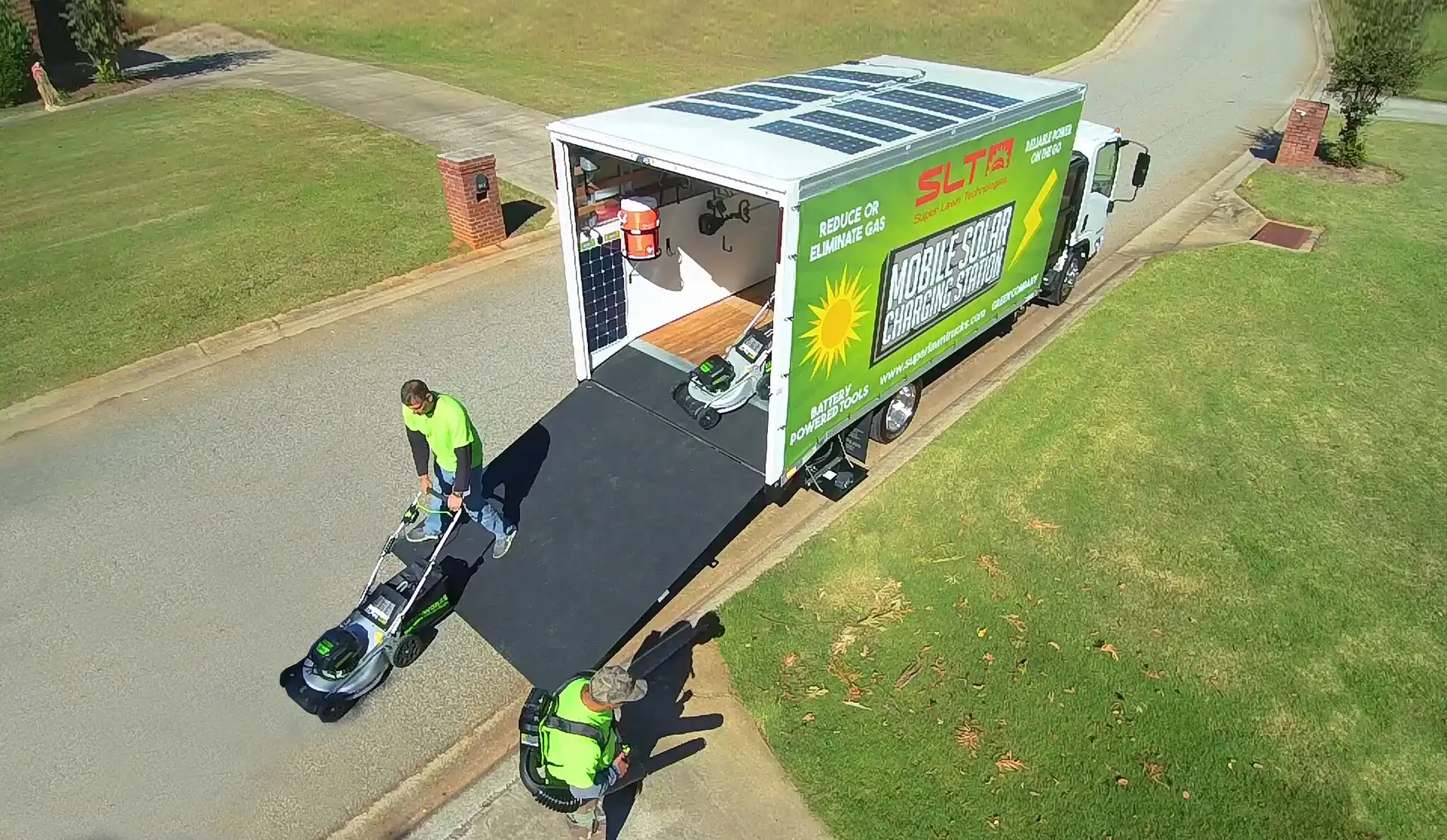How Solar is Transforming Work Truck Operations
Work truck fleet operators face a lot of challenges. They need to maximize vehicle ‘on the road’ time while minimizing operating costs to maintain profitability. Fleet owners must manage driver productivity, fuel costs, service call frequency, equipment replacement, and many other factors to meet their business objectives.
Liftgates, pallet jacks, and power truck peripherals are an ongoing source of frustration for fleet managers. These devices run off truck battery banks, and discharged batteries can lead to costly downtime and expensive service calls. In the past, fleet operators relied on generators or truck idling to keep batteries charged. But with higher fuel costs, idling restrictions, and environmental concerns, fleet operators are adopting work truck solar panel kits to help manage costs and boost their fleet uptime.
The True Cost of Traditional Battery Charging Solutions
For many fleet operators, large commercial generators have been their go-to solution to keep liftgate and peripheral equipment batteries charged. But generators are expensive to purchase and maintain, and increasing fuel costs are eating into the bottom line.
Generators are also loud and produce significant amounts of greenhouse gases. As a result, many jurisdictions — with California leading the way — are looking at restricting their use.
The established practice of idling trucks to charge batteries faces similar restrictions. Many operators are forced to choose between paying the fines for idling or incurring expensive service calls — $500-$700 per incident — when batteries run out of juice in the middle of a job.
Draining and recharging work truck batteries also impacts long-term battery performance, often leading to premature battery replacement, a significant expense for fleet operators.
Solar — A Better Alternative For Fleet Battery Charging
Advances in solar technology have made solar a compelling alternative for fleet operators looking for a better way to keep truck batteries charged.
Purpose-built work truck solar panel kits are designed to meet the tough demands of the commercial trucking and delivery industry. Solar panels for semi-trucks and other vehicles are mounted flat on the trailer or service body with minimal impact on the vehicle’s height or profile. These panels convert solar energy to supplement power from the truck alternator, keeping the liftgate and auxiliary batteries charged and healthy.
Next-generation solutions offer even greater utility and performance. For example, the Go Power! Phantom Smart Charging System is engineered specifically for electric pallet jacks and liftgates. The dual solar charging Phantom provides solar charging whether vehicles are parked or driving.
The Phantom system includes several innovations to provide fleet operators with charging flexibility and performance, including:
- Dual-source charging that automatically supplies power to two 12 or 24 volt DC sources with the dual in/dual out Phantom charge controller
- An intelligent charging function that boosts voltage to more effectively charge batteries
- A redesigned and rugged intelligent boost charger
- On-truck charging that allows electric pallet jacks to remain on the vehicle all the time, charged and at the ready
- Supports emergency charging between pallet jacks and liftgates
Weighing Solar’s Benefits for Fleet Operators
While retrofitting a work truck fleet for solar is a considerable investment, the benefits for fleet operators — financial and otherwise — can be compelling:
Reduced fuel consumption. Replacing generators and minimizing idling provide significant fuel cost savings for trucking companies. Eliminating idling during liftgate operation can save up to an estimated $40 per day per truck in fuel costs. And rising fuel prices are making solar’s return on investment even more favorable.
Less noise and pollution. Using work truck solar solutions eliminates generator pollution and noise and minimizes idling truck emissions.
Fewer service calls and missed deliveries. Dead liftgate batteries can lead to missed deliveries, expensive service calls, and big customer satisfaction issues.
Eliminate idling. Many drivers are forced to idle their rigs to charge their batteries, even in defiance of local regulations. As a result, they can receive thousands of dollars in tickets each year. Using work and semi-truck solar solutions can help fleet operators minimize their ticket costs.
Better driver productivity and fleet optimization. Trucking companies must optimize driver performance to maintain profitability. Service calls and idling trucks mean vehicles aren’t delivering, drivers are off the road, and profitability is suffering. Fleet solar systems help keep batteries charged and drivers on the move.
Improved battery performance and longevity. Over time, incorrectly charged batteries will suffer reduced performance and eventually fail, resulting in dead battery service calls and premature battery replacement. Work truck solar solutions keep batteries charged, healthy, and extend their lifespan. Fleet operators using best-in-class solar solutions can expect up to a four times greater lifespan for their liftgate and pallet jack batteries and a return on investment in as little as one year.
Lower maintenance. Unlike generators, solar systems don’t require regular, costly maintenance. Aside from keeping panels clean and the occasional system and component check, solar systems are virtually maintenance-free.
Easy to install. It’s simple and cost-effective for most fleet operators to retrofit their rigs with purpose-built solar solutions.
Work Truck Solar — Breaking Down the Components
Fleet applications are demanding, and work truck solar solutions require durable, high-performance components. While solar panels and batteries get the most attention, they’re only part of the work truck solar story.
Understanding Solar Panels — What You Need to Know
Solar panels are the backbone of the work truck solar system. Choosing the right panels will maximize the solar system’s efficiency, performance, and return on investment.
Solar panels consist of multiple individual solar cells that convert sunlight into energy. Panels are joined together to create a ‘solar array’ that generates more power. The solar panels generate the direct current (DC) electricity used to recharge the work truck batteries.
There are three types of solar panels available for work truck solar applications, each with its benefits and drawbacks:
Amorphous panels are older solar panels often found in first-generation installations. While inexpensive, they are fragile, inefficient, and take up the most room. They also degrade quickly when exposed to sunlight and can lose up to 30 percent of their power-generating capabilities in their first year of service. Today, amorphous panels are not widely used in commercial trucking applications.
Polycrystalline panels are more robust than their amorphous counterparts. They require half the space to produce the same power; however, polycrystalline panels can vary widely in quality and performance.
Monocrystalline panels are considered the most efficient solar panels, with energy efficiency rates typically in the 15-20 percent range. They perform better in high heat and low light environments, making them more versatile for fleet operators. While more expensive than polycrystalline options, monocrystalline panels are more durable and typically last longer.
Rigid Versus Flexible Panels
Rigid solar panels are built using a frame surrounding tempered glass covering the solar cells. Flexible panels, in contrast, have the collecting material embedded into a thin mylar film affixed to an aluminum substrate.
Rigid panels are very durable and typically have longer warranty periods than flexible panels. While flexible panels may be up to 80 percent lighter, they are much more susceptible to damage. Flexible versions are typically used when panels need to be molded to curved truck surfaces or accommodate height or weight constraints.
____________________
Solar Panel Buying Tips
Fleet operators should avoid purchasing cheap solar panels. They’re usually constructed with a lot of cut cells—they may be less expensive, but they’re also less efficient. Full, complete solar cells perform better and are worth the additional cost. Purchasers should also watch out for manufacturer claims of wattage output. The best manufacturers will provide a minimum output for their panels, as opposed to a maximum. Always ask your seller to document their panel output range (plus/minus percent).
____________________
Battery Basics
Work trucks use deep cycle, valve-regulated lead-acid (VRLA) batteries that can be regularly discharged and recharged. While older, absorbed glass mat (AGM) batteries are more common, lithium-ion batteries are quickly gaining popularity based on their efficiency, performance, and longevity.
AGM batteries do offer several benefits. They’re sealed, don’t spill or vent gas, and need no maintenance. AGM batteries charge quickly and are more resistant to low temperatures than gel alternatives. However, they require the use of a charge controller to prevent overcharging.
Lithium-ion batteries deliver high performance and efficient charging in a low-weight package and are safe, require no maintenance, and offer a long lifecycle. Fleet operators have known for some time that lithium batteries perform better than their traditional lead-acid counterparts, but lithium batteries were simply not cost-effective. With next-gen battery prices coming down, many operators now see a positive return on investment (ROI) and are moving ahead with retrofitting their fleets.
Here’s how operators are building the business case for lithium batteries:
Cost Savings. It’s a fact. Lithium batteries initially cost more — up to three times as much as their lead-acid counterparts. However, lithium cells last up to ten years, compared with an average of three years for lead batteries. As the cost of lithium batteries continues to fall, so does the difference in capital costs for the two battery solutions.
Efficiency. Lithium batteries are much more efficient than lead-acid cells, which translates into savings. Lead-acid batteries experience a decrease in amps during charging and a rapid drop in voltage during discharging. A lead-acid battery can also lose almost half of its energy due to heat, as opposed to approximately 15% for a lithium cell. Over time, the cost savings associated with charging lithium batteries versus lead-acid quickly add up.
Charging Speed. Lithium batteries charge much faster than lead-acid batteries, as they can accept much higher charge currents. It’s easier for operators to keep lithium batteries topped up with solar power during normal operations, minimizing the need for backup batteries or pausing to recharge. Less downtime means higher productivity for drivers and operators.
Stable Voltage Output. Unlike lead-acid batteries, lithium batteries maintain their voltage as they discharge, almost to full depletion. This reduces the current that passes through components and minimizes heat output, which helps extend the life of electrical equipment while reducing downtime, maintenance, and repair costs.
Reduced Battery Maintenance. Lead-acid batteries require regular maintenance — monitoring electrolyte levels, sometimes weekly watering, and terminals that must be checked for corrosion. Lithium batteries, however, are sealed and typically require no maintenance.
Storage and Safety. Lead-acid batteries must be placed and stored carefully, as they can vent potentially dangerous gases. For operators, this often means setting up a separate, well-ventilated room and training staff on how to respond in the event of acid spills or escaping fumes.
As lithium batteries do not vent gases, they can be stored in enclosed locations or secure common areas.
Are Lithium Batteries Right For Every Operator?
Depending on factors such as fleet usage (e.g., frequency and duration of truck rolls and deliveries) and investment in current battery infrastructure, lithium batteries may not be a cost-effective solution for every operator — at least not yet. However, as lithium adoption rises and prices drop, expect lithium batteries to replace lead-acid solutions for many fleet operators.
Understanding Power Inverters
While liftgates and many other work truck peripherals use DC power, more operators are seeing AC power requirements on their vehicles, including recharging tools, and running laptops. Converting DC power to usable AC power is the primary role of the power inverter.
There are two types of inverters — modified sine wave and pure sine wave. Modified sine inverters, while more affordable, use a basic form of technology that supplies power in an erratic fashion, with more peaks and ebbs in the flow.
Pure sine inverters provide ‘clean’ power very similar to what you receive in your home from your utility provider. Many modern electronic devices are susceptible to power fluctuations and won’t operate optimally with power from a modified sine inverter. Opting for a pure sine inverter ensures fleet operators will always get the best performance and life expectancy from AC work truck devices.
Choosing an Inverter — Buying Tips
Inverters should be purchased your inverter from a company with a proven track record and reliable customer support and have a full range of safety certifications (such as CSA and UL) to ensure safe, trouble-free operation.
More elaborate converters offer the ability to charge truck batteries when the vehicle is plugged into shore power or running a generator. Some inverters even allow you to ‘pass through’ AC directly to truck devices when plugged into shore power or to draw shore power and battery power simultaneously.
Inverter Installation and Operation Tips
Inverter location. Power inverters should be installed as close as possible to the DC battery bank to minimize any power loss between the two.
Wire gauge. Larger capacity inverters require larger gauge wire connections to the battery bank. For example, a 3,000-watt converter requires 0 gauge connectors. Using incorrectly-sized connectors will limit the available power and performance of your inverter.
Fuses. Installing a fuse for the inverter can prevent equipment damage or even a fire in the event of a short circuit or inverter failure. Fuses are sized according to inverter size — for example, a 110 amp fuse for a 1,000-watt inverter and a 400 amp fuse for a 3,000-watt unit.
Fuses should be installed as close to the truck battery bank as possible (typically less than 12 inches) and preferably in a watertight compartment.
Shutting the inverter off when not in use. If you’re not using any AC-powered devices, shutting the inverter off will eliminate any parasitic power draw from the inverter.
Charge Controllers — Getting the Most From Your System
The solar charge controller is an essential component of your work truck solar system. It regulates the voltage and current coming from the solar panels to the battery and preserves battery life by preventing batteries from overcharging.
When work truck batteries are low, the controller provides a full flow of current from the solar panels to replenish the battery banks. As the batteries achieve a 100% charge, the controller limits the current flowing from the solar panels to the batteries.
Basic single or two-stage controllers will shut off solar current when your battery is full; however, they are not typically used in commercial truck applications. Pulse Width Modulated (PWM) controllers offer more functionality — greater control of the current flowing from the solar panels and better battery ‘trickle charging.’
More sophisticated Maximum Power Point Tracking (MPPT) controllers are up to 30% more efficient than PWM controllers and provide even more control. However, the high cost of MPPT controllers may make them an impractical choice for some fleet operators.
____________________
Charge Controller Buying Tips
- Cheaply made charge controllers can emit significant electrical ‘noise’ and interfere with some electronic devices. Look for a charge controller that has been UL-certified or has undergone other independent standards testing.
- Consider emerging features like Bluetooth connectivity that will allow you to remotely monitor and manage your controller.
____________________
All About Power Converters and Transfer Switches
Power Converters
In work truck applications, the power converter (also known as a battery charger) takes AC power (typically from a generator or shore power) and converts it to the DC power used to charge the truck batteries. The best converters provide high throughput and shorten battery charging times, saving generator fuel.
Many upgraded converters offer a multi-stage charging feature with an equalization mode for better charging and improved battery life. Some also incorporate temperature compensation circuitry to adjust charge rates based on temperature — a feature that also helps extend battery life.
When To Disable Your Power Converter
Once truck operators remove any external AC hookups (generator or shore power), they should also shut off the power converter. Disabling the power converter eliminates any parasitic loop that may prematurely drain the battery bank. Once the operator reconnects AC power, they’ll need to reconnect the power converter.
Transfer Switches
Transfer switches automatically switch between two incoming AC power sources— for example, from a generator and an inverter. Separating AC power sources is critical for safety and the protection of your electrical equipment.
Transfer switches allow operators to select AC power sources based on their specific requirements.
Go Power! — Your Choice for Work Truck Solar
Outfitting a work truck fleet with solar represents a considerable investment for most operators. While solar offers many benefits, proper equipment selection, installation, and maintenance is critical to maximizing that investment.
Luckily, there’s help for fleet operators who don’t have the time, in-house expertise, or inclination to install their own solar systems. At Go Power!, we’ve been a leader in solar solutions since 1996 and have shipped more than a million solar panels. We’re experts in designing, installing, and maintaining work truck solar solutions. And, with a nationwide network of certified dealers, support for your Go Power! work truck solar solution is always close by.
Contact us to find out how Go Power! work truck solar solutions can help lower costs and boost profits for your business.




